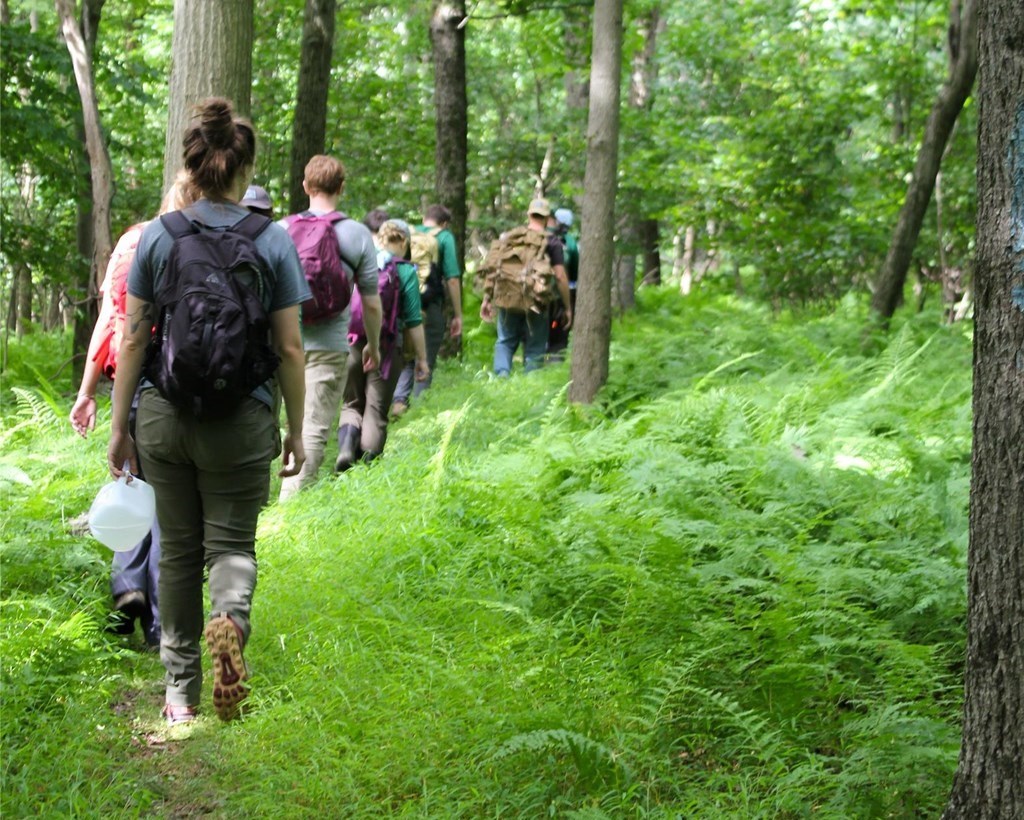Stewardship Projects and Programs
Science-based Land Management
“Sanctuary… we mean it!” — Maurice Broun

Hawk Mountain Sanctuary is maintained as a resilient ecosystem for raptors and other wildlife, and a place of retreat, inspiration, and modeled education for humans. The sacrosanctity of our Mountain is at the forefront of everything we do.
Ongoing Special Projects
Invasive Plant Remediation
Sanctuary Stewards have committed to a persistent and consistent annual attack on invasive plants as part of its long-term Invasive Plant Remediation Program. This work requires a dedicated team of invasive species specialists that identify and work to remove invasive non-native species that choke out native plants and reduce overall biodiversity of the forest. Key species include stilt grass, garlic mustard, barberry, and others using a summer team of remediation specialists and using a variety of best practices. These strategies require consistent removal, year after year, as well as measuring plots using GPS mapping to report success. The work also includes sharing best practices through public education, replanting as time and personnel allows, and documenting the work for the public and for funders.
Service Learning
Since its founding in 1934, Hawk Mountain Curator Maurice Broun used service learning to help improve the fledgling Sanctuary, manage its trails and forests, and help to build skills in young people. The Stewardship team continues this tradition today through Service-Learning Programs. Service Learning is an educational approach that combines meaningful volunteer work with instruction and reflection. Combined, this approach will enrich the experience, teach civic responsibility and leadership, encourage life-long civic commitment, and build stronger communities. At Hawk Mountain Sanctuary, that means "hands on and dirty" lessons, but with the satisfaction of serving on a team and celebrating that team’s accomplishments.
The Stewardship team is committed to creating Service-Learning opportunities that build a conservation ethic in self-motivated young people. Hawk Mountain is unique in its ability to also connect participants with high-level conservation professionals while they learn and implement best practices in forest management techniques, all in exchange for hard work and completion of goal-oriented projects.
The former Hawk Mountain Conservation Corps required a minimum of one year service/work commitment within a small group setting, and the corps helped to complete the Bauman Appalachian Wilderness Wall at the Education Building and to reconstruct major portions of the remote Skyline Trail to better reroute hikers and address storm water runoff. Current opportunities are designed based on interest and abilities, but include long-term invasive plant remediation, acorn propagation, native plant garden upkeep, and more. To become involved in Service-Learning, please contact Sanctuary Steward Noah Rauch at [email protected], subject line “Service Learning.”
Trail Stewards Program
Are you an experienced, enthusiastic hiker, willing to share your knowledge with others? If so, the Trail Stewards is a perfect fit for you! Trail Stewards provide an invaluable service, helping to interact with our growing number of hikers. Stewards hike our trails on weekend afternoons, especially remote trails, and share with people they encounter important information about trail routes, conditions, elevation gains, potential hazards, and more. A helpful and knowledgeable corps of Trail Stewards helps to reduce emergencies, keep hikers on the trail, and improves the overall visitor experience. Sign up on-site at the Visitor Center or contact Sanctuary Steward Steve Wade at [email protected].
Sanctuary Facilities
Throughout the year the Sanctuary Stewardship team conducts ongoing oversight and maintenance at the Acopian Center for Conservation Learning, the Education Building, the Amphitheater, and the Visitor Center, as well as its eight-site campground, two Adirondack shelters, and four private residence buildings. During winter, the team plans for the upcoming seasons by identifying issues, setting goals, and addresses facility upgrades as needed. Supplemental staff help manage the influx of visitors during autumn migration and peak fall foliage season, complete invasive plant remediation during summer months, and implement projects year-round.